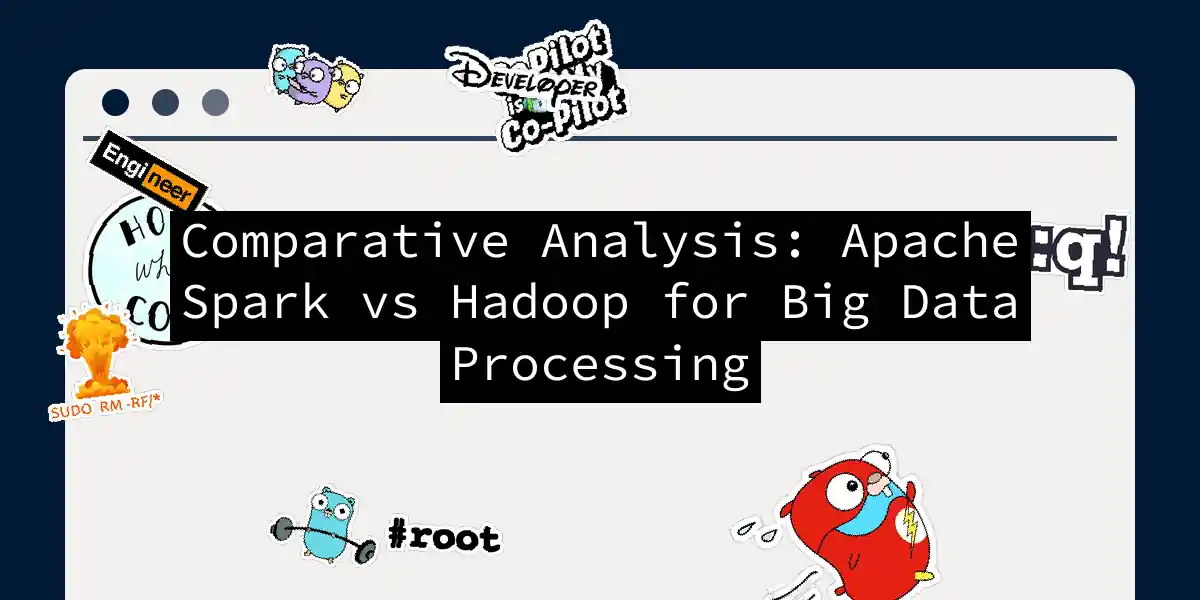Introduction to Big Data Processing
In the era of big data, two names stand out as giants in the field of data processing: Apache Hadoop and Apache Spark. Both are open-source frameworks developed by the Apache Software Foundation, but they serve different purposes and excel in different areas. This article will delve into the world of these two frameworks, comparing their features, use cases, and performance to help you decide which one is best for your big data needs.
What is Apache Hadoop?
Apache Hadoop is a collection of open-source modules and utilities designed to make the process of storing, managing, and analyzing big data easier. It includes modules like Hadoop YARN, Hadoop MapReduce, and Hadoop Ozone, among others. Hadoop is particularly known for its ability to handle large datasets across clusters of computers using simple programming models.
Key Features of Hadoop
- Batch Processing: Hadoop excels at batch processing large datasets. It uses the MapReduce programming model, which involves two main steps: “Map” and “Reduce.” This model is highly scalable and reliable but can be slower due to its disk-based storage.
- Scalability: Hadoop is highly scalable and can handle large volumes of data across many servers. It is cost-effective for building and scaling data processing pipelines.
- Fault Tolerance: Hadoop achieves fault tolerance through its HDFS file system, which replicates data across multiple nodes.
What is Apache Spark?
Apache Spark is an open-source data processing engine built for efficient, large-scale data analysis. It is frequently used by data scientists to support machine learning algorithms and complex data analytics. Spark can be run either standalone or as a software package on top of Apache Hadoop.
Key Features of Spark
- In-Memory Processing: Spark’s in-memory computation capabilities make it significantly faster than Hadoop. It processes data in RAM, which reduces the time required for multiple operations on the same dataset.
- Streaming and Real-Time Processing: Spark Streaming allows for real-time data processing, ingesting data in mini-batches and performing transformations on those mini-batches. This makes Spark ideal for applications requiring low-latency responses.
- Machine Learning: Spark includes a machine learning library called MLlib, which supports regression analysis, classification, and other machine learning tasks. This makes Spark a preferred choice for tasks involving machine learning.
Comparison of Hadoop and Spark
Batch Processing
Hadoop’s batch processing is designed for high-throughput processing of large datasets. It is highly scalable and reliable but slower due to its disk-based storage. On the other hand, Spark’s batch processing is highly efficient due to its in-memory computation capabilities, making it faster but potentially more memory-intensive.
Streaming and Real-Time Processing
Hadoop itself does not support real-time data processing. However, real-time processing can be achieved with additional components like Apache Storm or Apache Flink. Spark, however, supports real-time data processing through Spark Streaming, which processes data in mini-batches.
Ease of Use
Spark is generally easier to learn and use compared to Hadoop. Spark has a simpler interface and fewer core modules, making it more developer-friendly. Hadoop, on the other hand, has a more complex architecture and a steeper learning curve.
Performance
Spark is significantly faster than Hadoop, especially for iterative and interactive workloads. This is due to Spark’s ability to perform in-memory computations, whereas Hadoop relies more on disk-based storage. Spark can be up to 100 times faster than Hadoop for small workloads.
Use Cases
When to Use Hadoop
- Batch Processing: Hadoop is ideal for tasks that require the processing of large datasets without real-time constraints. For example, generating non-time-sensitive inventory reports from tens of thousands of records.
- Data Warehousing: Hadoop’s ability to store and process vast amounts of structured and unstructured data makes it a popular choice for data warehousing and business intelligence applications.
- Exploratory Data Analysis: Hadoop’s distributed architecture and fault tolerance make it well-suited for exploratory data analysis tasks.
When to Use Spark
- Real-Time Analytics: Spark is the better choice for tasks that require real-time data processing. For example, financial institutions use Spark to detect fraud in ongoing transactions.
- Machine Learning: Spark’s built-in machine learning library, MLlib, makes it more suitable for tasks involving machine learning and AI algorithms.
- Interactive Analytics: Spark’s in-memory processing and high-level APIs make it ideal for interactive analytics and emerging use cases demanding real-time insights.
Practical Example: Choosing Between Hadoop and Spark
Let’s consider a scenario where a company needs to analyze customer purchase data to generate insights for marketing campaigns.
In this example, Hadoop is used for batch processing large datasets of historical purchase data, while Spark is used for real-time data processing and generating insights through machine learning models.
Conclusion
Both Apache Hadoop and Apache Spark are powerful tools in the world of big data processing, each with its own strengths and weaknesses. Hadoop excels in batch processing and is highly scalable, making it ideal for tasks that require fault tolerance and high throughput. Spark, on the other hand, is designed for real-time data processing and machine learning, leveraging its in-memory computation capabilities to deliver faster performance.
When deciding between Hadoop and Spark, consider the nature of your data, the processing requirements, and your organizational objectives. By understanding the unique benefits of each framework, you can make an informed decision that aligns with your specific needs and ensures you get the most out of your big data initiatives.
